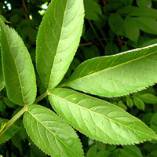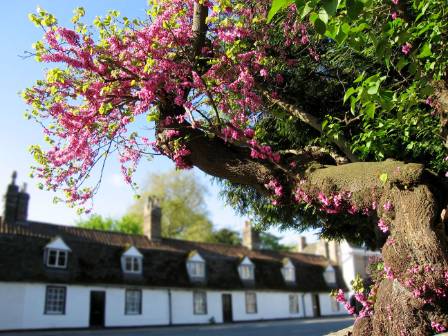I'm completely in awe of trees. Especially the trees that flourish, magically, amidst the concrete and bricks, and the metal, rubber and glass of London's busy streets, where I live and work.
So I'm very happy to be telling you about our new online Urban tree survey. This nationwide survey, that launched on Friday 16 July, will be one of the biggest tree surveys ever.
A Judas tree in Cambridge © Andrew Dunn. This was our Species of the day to mark the launch of the Urban tree survey.
Although we know a lot about Britain's rural tree population, relatively little is known about the trees in urban areas. We're being invited to record particularly what's in our private gardens and local streets and parks of urban Britain, so our scientists and botanists can build a picture of what trees are growing where, and also find out how the urban tree population is changing.
Our survey focuses on 80 different types of tree normally associated with an urban environment.
I'm told that one of our most widespread trees is the sycamore, and in urban areas, the closely related norway maple may be as common or more so. These species were introduced to the UK. But we don't have actual numbers for the most common trees, only data on which are most widespread.
There are lots of resources on the Urban tree survey website to help with tree identification and advice on how to take part in the survey.
I recommend watching the Identify trees video first, which shows you what things to look out for to identify your trees correctly. Especially enjoyable because it's filmed in Holland Park, one of London's best parks in my opinion.
 To record your findings on the survey, choose an area you want to survey first, and think about the things you'll need to consider before you start recording your trees. For example, are the tree leaves hairy? Are they needle-like or scale-like, broad or lobed? What about fruits or cones? Petals, twigs, bark and importantly what does it smell like? The Tree identification key which you can download and take with you, will help with all this. You can check your identification using our online interactive identification key.
To record your findings on the survey, choose an area you want to survey first, and think about the things you'll need to consider before you start recording your trees. For example, are the tree leaves hairy? Are they needle-like or scale-like, broad or lobed? What about fruits or cones? Petals, twigs, bark and importantly what does it smell like? The Tree identification key which you can download and take with you, will help with all this. You can check your identification using our online interactive identification key.
Read the news story about the Urban tree survey for some fascinating facts about the survey and our knowledge of trees.
Explore the lovely Judas tree Species of the day that marked the launch of the survey and is the main photo above. It's also featured in the survey. Now where did it get its name, I wonder?
Are these leaves from an elder or ash? Check your tree knowledge on the survey's ID key chart
The Urban tree survey will run for 3 years and our Cherry tree survey launched this spring is part of it.
Leaves image © Università di Trieste, Dipartimento di Biologia. Photo: Andrea Moro



